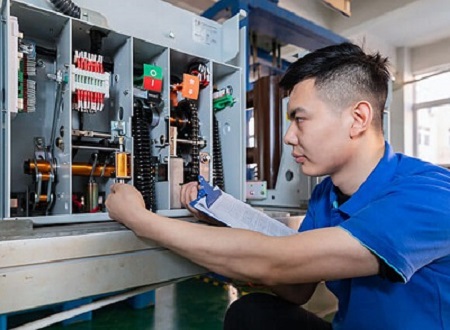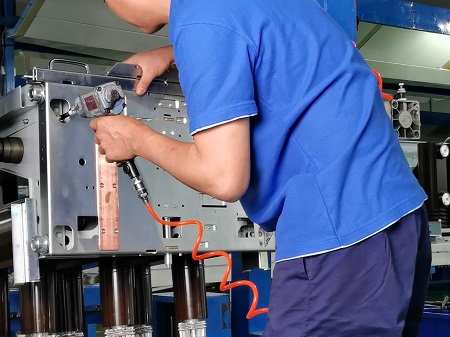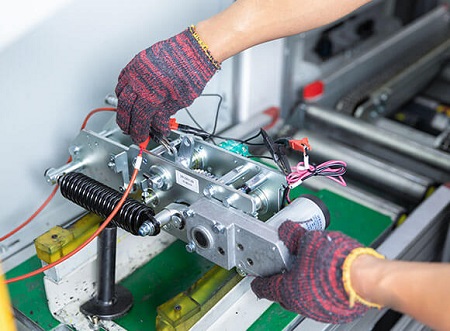Home » How To Do The Vacuum Circuit Breaker Maintenance
Circuit breakers are a safety device that assures us a certain level of protection from overload, short circuits, and other faults in the electric supply. When there is a fault, the vaults are trusted with the responsibility of clearing up the issue quickly. However, if there is a problem with the circuit breaker, it will not be able to tackle the problem efficiently and rapidly. Thus, the maintenance of circuit breakers is important.
Vacuum circuit breakers are one of the most common types of circuit breakers. In this blog, we will specifically discuss the testing, maintenance, and troubleshooting measures of vacuum circuit breakers. In other words, this blog is a one-stop destination for everyone looking for both mv and hv vacuum circuit breaker maintenance lately.
A vacuum circuit breaker uses a vacuum for the extinguishing or extinction of arc. The typical parts of a vacuum circuit breaker are moving contact, fixed contact, and an arc shield inside a vacuum interrupter or vacuum chamber. There are multiple benefits of using both the hv and mv vacuum circuit breaker. They have a longer life span, are compact in size, have high dielectric strength, no fire or explosion hazards, no gas generation, and others. They are silent while operating too.
In a vacuum circuit breaker, the vacuum contactor units are present in a vacuum chamber. When the two contacts move away and the circuit breaker is opened inside the contact vacuum, an arc is produced due to the ionization of the metal vapors of contact. This arc is quickly quenched by the vacuum since the ionized metal vapors, ions, and electrons that are generated get condensed on the surface of the circuit breaker contacts, resulting in the arc extinction.
When the arc is produced, it is extinguished as well because of the faster recovery rate of the dielectric strength.
Even though vacuum circuit breakers are low in maintenance, environmental elements such as moisture or dust get deposited on them while functioning. Corrosive contaminants present in the atmosphere can also cause damage to several parts of the circuit breaker. Hence, testing and maintenance become important for different types of vacuum circuit breakers like draw out breaker, high voltage or medium voltage circuit breakers, and others.
It is important to understand the vacuum circuit breaker maintenance procedure.

The first step is testing which helps us to know if there are any major faults or if something requires repair or replacement. The testing of vacuum circuit breakers involves various types of visual, mechanical, and other tests which are discussed in detail below.
Visual Inspection
The visual check is the simplest and primary one. Various parts such as drive insulators and molded pole unit support can be checked visually for dirt and cracking. Similarly, the control circuit parts such as wiring and terminals can also be checked for their intactness. For testing dirt and dust in the operating mechanism, a visual check is there. Sometimes, along with visual inspection, one can also feel and sense to inspect the parts e.g., for checking the tightness of circuit breaker operating mechanism or hardware.
Vacuum Interrupter Integrity Test
The reliability of a vacuum circuit breaker depends upon the integrity of the vacuum and the internal dielectric strength. For checking both of them, vacuum interrupter testing is arranged. The vacuum circuit breaker testing procedure is also known as a hipot test because a high potential is applied during the testing.
This one-minute ac high potential test is used to check the insulation integrity from the main circuit to ground, from the control circuit to ground, and between main circuit terminals. A successful withstand indicates the good functioning of the vacuum interrupters whereas a break-down indicates that there is a defective interrupter or interrupters that needed to be repaired or replaced.
Mechanism Check
The mechanism check involves visual inspection of the mechanism for any loose parts such as rings, bolts, and others. The other parts of mechanism check can include measurement check, functional check, operational check, or a combination of these. The measurement check is required for the inspection of vacuum interrupters for the visibility of three contact erosion indicators and contact wipe measurement.
For checking the smooth functioning of a motor, a functional test is required. Similarly, for excessive wearing or deformation of the operating mechanism, both visual and operational checks are required. Sometimes, for the checking of the correct and smooth operation of certain parts, closing, tripping of the circuit breaker, or manual charging is also employed.

Maintenance of vacuum circuit breakers is easy and not that complex, be it indoor vacuum circuit breaker or high voltage circuit breaker maintenance. Yet, we need to be careful while maintaining the maintenance procedure to ensure the smooth functioning of the circuit breaker for a longer period of time.
Preventive measures can be considered of key importance in vcb operation and maintenance.
Insulation
This is one of the simplest maintenance techniques. Insulation maintenance applies to the cleaning of all the insulation surfaces. Any soft cloth like a dry lint-free cloth or dry paper towel can be used to wipe off the dust from the insulation surfaces to ensure their smooth functioning.
If wiping is unable to remove dust properly, distilled water or a mild solvent can be used for the purpose of removing dirt and dust. Once wiped, make sure that all the surfaces have completely dried up before placing the circuit breaker in service. Inspect for any damage to the insulation and ensure that all the wires are tightly connected before putting the circuit breaker back in use.
Lubrication
Proper lubrication is required periodically to ensure the overall smooth and correct functioning of all the parts of a vacuum circuit breaker and vcb maintenance. The gap between relubrication depends on the frequency of the circuit breaker used. Generally, it is suggested to go for relubrication once a year.
For lubrication, a drop of light machine oil can be used. After lubrication, the circuit breaker needs to be operated several times manually and electrically so that the oil is absorbed into the parts properly. Roller bearings come packed with a high-quality slow-oxidizing grease from the vacuum circuit breaker manufacturer itself. Hence, they should be lubricated only when needed.

In the troubleshooting process, mainly two types of problems are detected which are discussed with their solutions below.
Closing Problem
In the mechanism or control circuit, if a certain part cannot be closed, then replacement is needed. If there is a closing sound but the breaker remains open, then check the alignment or go for replacement. If it is closing without losing signal, then realignment or replacement is required.
Tripping Operation
If the operating mechanism or control circuit parts cannot trip, go for replacement. If there is a tripping sound but the breaker remains closed, replacement is required. Similarly, replacement is the solution for a trip without tripping signal too.
In order to properly provide maintenance services to the vacuum circuit breaker, it is essential that the VCB is first switched off. Once it is off, it should be isolated from all sides. You need to open up the electrical isolator to do this.
Follow the below steps then for proper maintenance:
A vacuum circuit breaker does not come with high maintenance but it still requires periodic inspection, maintenance, and troubleshooting for its smooth and reliable operation. Before going for the periodic maintenance or testing of a vacuum circuit breaker, take the necessary precautions.
Always use professional help or tools for performing any mechanical activity. In this blog, we have discussed the testing, maintenance, and troubleshooting procedure, all in one place, along with the design and functioning of a vacuum circuit breaker in detail.
Equip your business with long-lasting switchgear components that respond to your needs and smoothen electrical operations at affordable costs.
Supported File : JPG, AI, PNG, PDF, CAD, JPEG